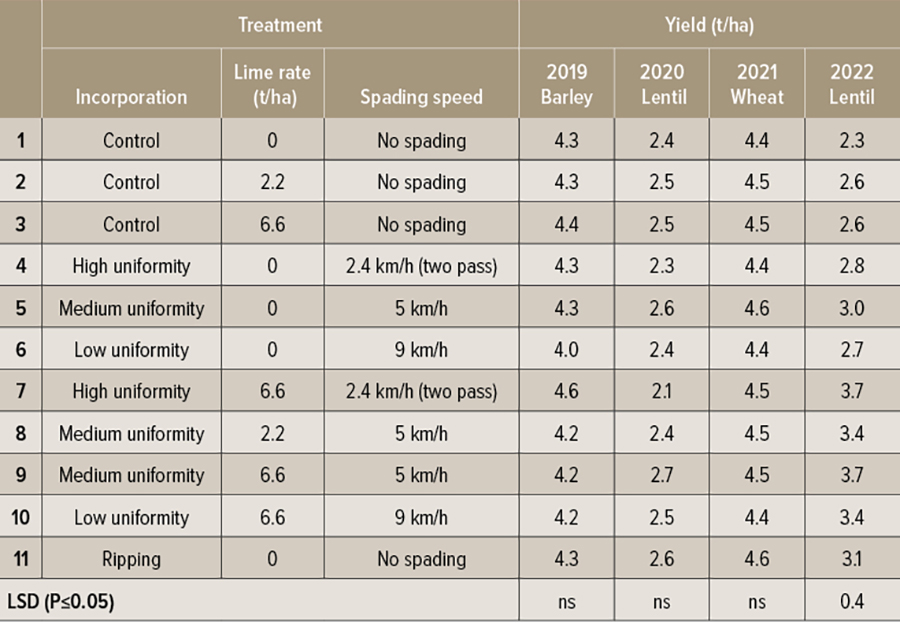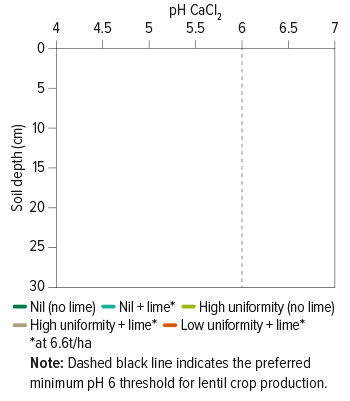Subsurface soil acidification has been identified as a significant and increasing soil constraint in no-till farming systems across southern Australia.
Given the slow rate at which surface-applied lime moves into untilled soil, strategic tillage has been considered the best way to correct subsurface acidity within a reasonable time frame. Now, the results of a four-year study indicate spading could improve soil pH and increase lentil yields across a range of liming rates and spading speeds.
These results suggest growers can benefit by incorporating moderate rates of surface-applied lime with spading, although heavier applications and slower speeds (for greater uniformity of mixing) could deliver faster and more beneficial outcomes for subsurface acidity.
GRDC’s Acid Soils Southern Region project “Updating acidification rates, lime recommendations and extension aids to overcome soil acidity constraints to crop production in the southern region”, led by the South Australian Department of Primary Industries and Resources (PIRSA), has been exploring liming strategies to address the problem of subsoil acidification in southern cropping systems.
No-till systems are a particular focus, given the propensity for subsurface acidity to develop in untilled and regularly cropped paddocks, especially in sandy soils.
Studies have shown that lime is unlikely to move through untilled soil at more than 2.5 centimetres per year, meaning surface-applied lime could take 10 years to mitigate a subsurface acid layer at 25cm depth.
Trial site constraints
A trial site was established at Bute in the northern Yorke Peninsula in 2019 by Dr Jack Desbiolles and Dr Mustafa Ucgul from the University of South Australia in collaboration with CSIRO and Trengove Consulting, as part of GRDC’s “Increasing production on sandy soils in low and medium-rainfall areas of South Australia” investment.
The site was then continued in 2022 by Trengove Consulting, under the “Acid Soils Southern Region” project.
 Figure 1. Starting soil pH measured in 5cm increments, spading uniformity trial, Bute, SA.
Figure 1. Starting soil pH measured in 5cm increments, spading uniformity trial, Bute, SA.
Research agronomist Sam Trengove says the site originally exhibited some notable soil constraints.
“The soil was characterised as red sand transitioning to red sandy clay at a depth of about 30cm, with acidity levels ranging from moderate to highly acidic between 5cm and 25cm (Figure 1).
“There was also a compacted layer from 15cm to 40cm, where soil penetrometer readings exceeded 2500 kilopascals.”
Using the Lime Cheque calculator from the Acid Soils Southern Region website, lime with an effective neutralising value of 93 per cent was applied at rates of 2.2 tonnes per hectare (typical practice, enough to treat zero to 10cm) and 6.6t/ha (enough to treat the zero to 30cm layer).
The trial design included 11 treatments to compare lime application rates and spading incorporation strategies (Table 1).
The spading treatments were targeted to a depth of 30cm, while a deep-ripping treatment to least 40cm depth was also included for comparison.
The high-uniformity spading treatment was designed to achieve maximum mixing of lime and soil by including two passes in the same direction at 2.4 kilometres per hour.
Medium-uniformity spading represented more-common spading practice, and involved a single pass at 5km/h. The low-uniformity treatment used a single pass at 9km/h.
Table 1. Grain yield (t/ha) for lime uniformity trial at Bute, SA, 2019 to 2022.

The treatments were implemented on 11 May 2019, prior to sowing RGT Planet barley on 15 May 2019. In subsequent years, the trial was planted to PBA Hallmark XT lentils in 2020, Chief CL Plus wheat in 2021 and PBA Highland XT lentils in 2022 (Table 1).
Grain yields in the first three years of the experiment were generally high by local standards, with no distinct variation between the different liming, spading or ripping treatments (Table 1).
In-season normalised difference vegetation index (NDVI) readings showed a positive growth response to lime incorporated by spading in lentils in 2020, but this did not translate into a measurable grain yield increase.
“While year two was still quite early for lime to be having much effect, we typically expect in-season growth responses to translate to grain yield in lentils grown on these constrained soils,” Mr Trengove says.
“In this case, we suspect the disconnect between biomass and grain yield results was mostly due to the weather in 2020, which was characterised by a dry winter and early spring, followed by 83 millimetres of late-season rain, which triggered regrowth with late flowering and pod set.”
In year four (2022), lentil grain yields for the control treatment were 2.33t/ha, but improved by up to 58 per cent as a result of liming with spading. These results were more consistent with that year’s in-season NDVI readings.
“The insignificant difference between the high and medium-uniformity spading treatments with 6.6t/ha lime indicates growers could use higher (typical) spading speeds with little penalty,” Mr Trengove says.
“The yield gains from spading and deep ripping without lime are consistent with studies showing these treatments can benefit crop performance by reducing or removing compaction constraints for improved root growth and exploration.”
Effects on soil resistance
Soil resistance was reduced by the deep ripping and all spading treatments. However, the maximum spading depth of 300mm left a residual hard layer, with average soil resistance across medium-uniformity replicates exceeding 2500kPa at depths of 25cm to 40cm.
Deep ripping to at least 400mm reduced soil resistance below 2500kPa throughout the soil profile.
Correcting subsurface acidity
Soil pH was assessed again before seeding in 2022 (three years after lime application) and showed positive responses that were directly related to the incorporation treatment used (Figure 2).
“Where the lime treatments were not incorporated by tillage, soil pH in the top zero to 5cm did increase via annual furrow seeding, but there was no benefit at depths below the surface,” Mr Trengove says.
 Figure 2. Soil pH (CaCl2) sampling for incorporation treatments in the spading uniformity trial 2022.
Figure 2. Soil pH (CaCl2) sampling for incorporation treatments in the spading uniformity trial 2022.
Lime applied with low-uniformity spading improved pH to a depth of at least 20cm compared to the nil lime and nil incorporation treatments, although pH remained less than 6.0 below 10cm.
“In contrast, high-uniformity spading most effectively increased soil pH above 6.0 to a depth of 20cm and also significantly increased pH in the deepest sample interval of 20 to 30cm.”
Further to these soil pH improvements, dry matter, grain yield, root nodulation and nitrogen fixation were all seen to improve across the incorporation treatments in year four’s (2022) lentil crop.
The different levels of mixing uniformity imposed by the three spading treatments indicate the level of soil pH change and crop response that might be expected from other tillage tools that provide equivalent levels of mixing uniformity. These results provide some insight into the benefits of optimising machine selection and set-up for job quality, costs and return on investment.
Unsurprisingly, ripping alone (Table 1, Treatment 11) consistently produced yields significantly higher than the control (although lower than best-performing liming treatments), highlighting the importance of identifying and addressing multiple constraints that are present in the soil.
“Using strategic tillage to incorporate high rates of lime is a faster and more-effective way to correct subsurface acidification on some soil types,” Mr Trengove says.
“Appropriate tillage could allow farmers who normally run a no-till system to correct acid layers and return constrained sandy soils with acidity to 25 to 30cm deep to productivity eight to 10 growing seasons sooner than applying lime at the surface.”
More information: Sam Trengove, samtrenny34@hotmail.com, 0428 262 057

























































